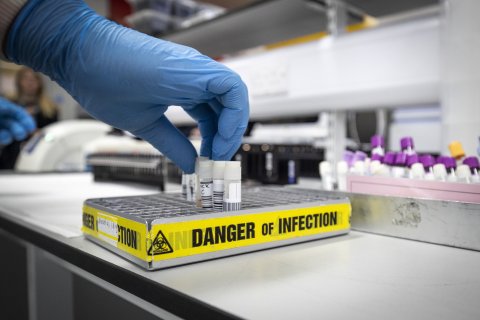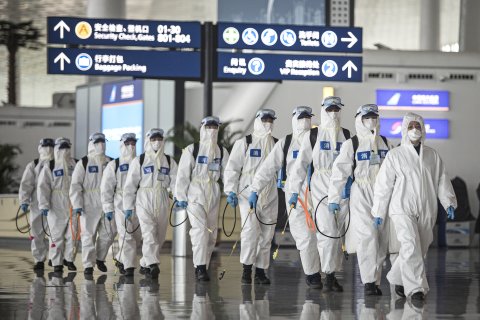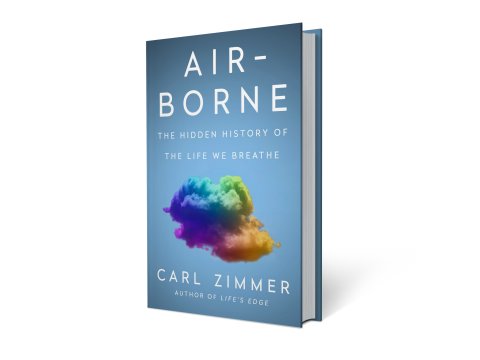
Q&A: Carl Zimmer on airborne diseases: 'These are all big concerns'
"I have two thoughts about gratitude," she said. "I'm very grateful for Skagit County. If you look in the woods, everything is blooming. And I am grateful for all the scientists who made the vaccines that let us be here."
The choir began with a hymn. At the cue of Yvette Burdick, the choir director, the singers dropped their diaphragms. They inhaled the concert hall air deep into their lungs, into the fine alveoli at the deepest tips of their airways. The oxygen in the air seeped into their bloodstreams, while carbon dioxide outgassed. The singers then let their lungs deflate, and the altered air made its way back up through their bronchi, into their tracheas and through their larynxes. Bands of muscle buzzed in the upwelling breeze and produced a spectrum of sound. The singers set their mouths into different shapes, to sculpt the acoustic waves as they escaped.
The sound raced across the hall, the waves jostling molecules of air and bouncing off walls. The waves ended up in our auditory canals, making our eardrums vibrate and generating electrical signals that entered our brains, where they produced the perception of sound. The physics of the air joined us in a communion as the choir shared songs about gratitude: for the Earth, for liberation from slavery, for love. "Place me like a seal over your heart, like a seal on your arm," the vibrations told us.
Read more
Q&A: Carl Zimmer on airborne diseases: 'These are all big concerns'

Mount Vernon Choir Sees Early Surge in COVID-19 Cases
On May 5, 2023, the day before the spring concert, the World Health Organization made a major announcement. Speaking in Switzerland at a press conference, WHO director Tedros Adhanom Ghebreyesus declared that COVID‑19 was no longer a public health emergency of international concern. Three years and five months had passed since the coronavirus SARS‑CoV‑2 emerged in Wuhan, China. COVID‑19, a disease never seen before, became the worst public health disaster of modern times, infecting the majority of people on Earth. By the time Tedros made his announcement, it had killed about 25 million of them. Some of the first people in the world to get COVID‑19 stood before us on the McIntyre Hall stage. On March 10, 2020, 58 members of the Skagit Valley Chorale had become infected at a rehearsal. Before the month was out, three were in the hospital. Two of them died. The outbreak brought horror to the choir and also shock. They knew that some diseases can spread in droplets slathered on doorknobs or fired at close range in coughs and sneezes. But subsequent research would reveal that the Skagit Valley Chorale outbreak was likely spread on a song. An infected singer released an invisible cloud of droplets so tiny that they resisted gravity and floated like smoke. She did not cough or sneeze to unleash the viruses: they escaped with every breath. COVID‑19, in other words, was airborne.Scientists Begin Rethinking How Illnesses Spread Due to COVID-19
I am a journalist, and diseases are one of my beats. I became aware of the new virus in early January 2020, while it was still in China. By late January, a few scientists were predicting a pandemic. I started warning my friends to brace for a possible disaster. Like a paranoid doomsday prepper, I advised them to store extra toilet paper and canned food. When someone called me to plan a meeting in June, I told him meetings might not exist in June. I was right in some ways and very wrong in others. Like the Skagit Valley Chorale, I did not concern myself with the air. If I stayed a few feet away from strangers, I'd be safe from any viruses they coughed or sneezed. The droplets they expelled would fall to the floor like ball bearings. The most worrisome risk seemed to lurk on surfaces: the skin of my hands, which I washed many times a day; the grocery bags that I disinfected with Clorox wipes. Over the following months, I absorbed the growing consensus that COVID‑19 was in fact airborne. As I recognized that floating droplets could transmit the virus from one person to another, I traded Clorox wipes for a carbon dioxide monitor. Masks became a staple. I also began to think about the air differently, as a gaseous ocean in which we all live, which infiltrates our bodies, which our own bodies transform and then return to the great transparent sea, that contains exhaled viruses that can then be inhaled. But I was also left with a question: how could such a fundamental mystery about the worst public health disaster in a century go unsolved for so long? Once the pandemic passed its peak—after most people on Earth got infected, vaccinated or both—I started looking for an answer. It became clear that for thousands of years the atmosphere had been an intimate, enveloping mystery. For hundreds of generations, scholars and physicians had claimed the air itself could turn dangerous. They gave bad air an assortment of names, such as miasma. Miasmas could be caused by the stars or swamps; they could spread down a street or float for hundreds of miles. When modern Western medicine took shape in the late 1800s, scientists and doctors alike tossed miasmas aside, treating them like an embarrassing relic of the Dark Ages, a concept with as much value to medicine as bleeding patients. They knew that germs spread diseases, and they knew that germs spread primarily through food, water, sex and touch, as well as through coughs and sneezes. Germs were not airborne. But in the 1930s, a few scientists challenged this consensus. They argued that diseases could indeed spread on currents, that germs could float for hours like smoke. They recognized that airborne pathogens posed a fundamentally different threat than the one posed by short‑range coughs and sneezes. They argued that some of the worst diseases known to humanity, such as tuberculosis and influenza, spread this way. Those scientists helped create a new field: the science of airborne life. They called it aerobiology.
Fresh Air
The Skagit Valley Chorale singers finished their concert and then took their bows. As the audience cheered, I checked my CO2 monitor. The level of carbon dioxide—527 parts per million when they'd begun singing—had reached 903 parts per million. Outside, the level was hovering around 420. In our communion, we had altered the air. After the applause ended, my wife and I filed out into the high-ceilinged lobby. We congratulated Burdick and Backlund, passed by the fifth graders swarming their teacher as if she were Taylor Swift, pushed open the outer doors and walked into the night air. It was the same air we had just breathed inside McIntyre Hall, the same seamless blanket of gases. The only difference now was there was no ceiling to hold it down. I could exhale all the carbon dioxide I wanted, but my CO2 monitor would not budge.
Request Reprint & Licensing
Submit Correction
View Editorial Guidelines
To read how Newsweek uses AI as a newsroom tool, Click here.


